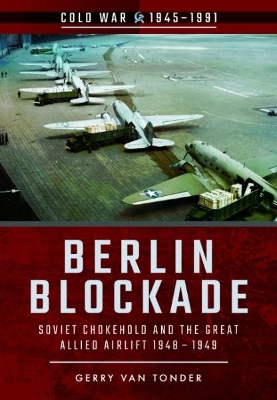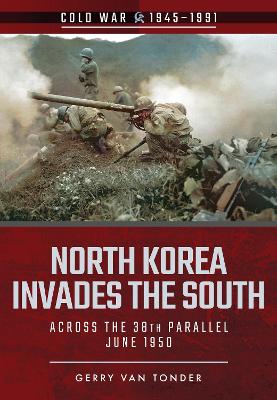Cold War
4 total works
When the world held its breath It is 25 years since the end of the Cold War, now a generation old. It began over 75 years ago, in 1944 long before the last shots of the Second World War had echoed across the wastelands of Eastern Europe with the brutal Greek Civil War. The battle lines are no longer drawn, but they linger on, unwittingly or not, in conflict zones such as Iraq, Somalia and Ukraine. In an era of mass-produced AK-47s and ICBMs, one such flashpoint was Berlin. Allied agreements entered into at Teheran, Yalta and Potsdam for the carving up of post-war Berlin now meant nothing to the Soviet conquerors. Their victory had cost millions of Russian lives troops and civilians so the hammer and sickle hoisted atop the Reichstag was more a claim to ownership than success. Moscow s agenda was clear and simple: the Western Allies had to leave Berlin. The blockade ensued as the Soviets orchestrated a determined programme of harassment, intimidation, flexing of muscle, and Socialist propaganda to force the Allies out. Truman had already used the atomic bomb: Britain and America would not be cowed.History s largest airborne relief programme was introduced to save the beleaguered city.
In a war of attrition, diplomatic bluff and backstabbing, and mobilizing of forces, the West braced itself for a third world war.
In a war of attrition, diplomatic bluff and backstabbing, and mobilizing of forces, the West braced itself for a third world war.
When the world held its breath It is more than 25 years since the end of the Cold War. It began over 75 years ago, in 1944 long before the last shots of the Second World War had echoed across the wastelands of Eastern Europe with the brutal Greek Civil War. The battle lines are no longer drawn, but they linger on, unwittingly or not, in conflict zones such as Syria, Somalia and Ukraine. In an era of mass-produced AK-47s and ICBMs, one such flashpoint was Korea Without warning, at 4.00 a.m. on 25 June 1950, North Korean artillery laid down a heavy bombardment on the Ongjin Peninsula, followed four hours later by a massive armoured, air, amphibious and infantry breach of the ill-conceived post-war border that was the 38 north line of latitude. At 11.00 a.m., North Korea issued a declaration of war against the Republic of Korea. Three days later, the South Korean capital, Seoul, fell. The attack upon Korea makes it plain beyond all doubt that Communism has passed beyond the use of subversion to conquer independent nations and will now use armed invasion and war. A week after his reaction to the North Korean invasion, US President Harry S.
Truman, in compliance with a UN Security Council resolution, appointed that iconic Second World War veteran, General Douglas MacArthur, commander-in-chief of forces in Korea. The first in a six-volume series on the Korean War, this publication considers those first few fateful days in June 1950 that would cement north south antagonism to this day, the pariah state that is communist North Korea a seemingly increasing threat to an already tenuous global peace.
Truman, in compliance with a UN Security Council resolution, appointed that iconic Second World War veteran, General Douglas MacArthur, commander-in-chief of forces in Korea. The first in a six-volume series on the Korean War, this publication considers those first few fateful days in June 1950 that would cement north south antagonism to this day, the pariah state that is communist North Korea a seemingly increasing threat to an already tenuous global peace.
When the world held its breath It is 25 years since the end of the Cold War, now a generation old. It began over 75 years ago, in 1944 long before the last shots of the Second World War had echoed across the wastelands of Eastern Europe with the brutal Greek Civil War. The battle lines are no longer drawn, but they linger on, unwittingly or not, in conflict zones such as Iraq, Somalia and Ukraine. In an era of mass-produced AK-47s and ICBMs, one such flashpoint was Malaya By the time of the 1942 Japanese occupation of the Malay Peninsula and Singapore, the Malayan Communist Party (MCP) had already been fomenting merdeka independence from Britain. The Japanese conquerors, however, were also the loathsome enemies of the MCP s ideological brothers in China. An alliance of convenience with the British was the outcome. Britain armed and trained the MCP s military wing, the Malayan People s Anti-Japanese Army (MPAJA), to essentially wage jungle guerrilla warfare against Japanese occupying forces.With the cessation of hostilities, anti-Japanese became anti-British, and, using the same weapons and training fortuitously provided by the British army during the war, the MCP launched a guerrilla war of insurgency.
Malaya was of significant strategic and economic importance to Britain. In the face of an emerging communist regime in China, a British presence in Southeast Asia was imperative. Equally, rubber and tin, largely produced in Malaya by British expatriates, were important inputs for British industry. Typically, the insurgents, dubbed Communist Terrorists, or simply CTs, went about attacking soft targets in remote areas: the rubber plantations and tin mines. In conjunction with this, was the implementation of Mao s dictate of subverting the rural, largely peasant, population to the cause. Twelve years of counter-insurgency operations ensued, as a wide range of British forces were joined in the conflict by ground, air and sea units from Australia, New Zealand, Southern and Northern Rhodesia, Fiji and Nyasaland.
Malaya was of significant strategic and economic importance to Britain. In the face of an emerging communist regime in China, a British presence in Southeast Asia was imperative. Equally, rubber and tin, largely produced in Malaya by British expatriates, were important inputs for British industry. Typically, the insurgents, dubbed Communist Terrorists, or simply CTs, went about attacking soft targets in remote areas: the rubber plantations and tin mines. In conjunction with this, was the implementation of Mao s dictate of subverting the rural, largely peasant, population to the cause. Twelve years of counter-insurgency operations ensued, as a wide range of British forces were joined in the conflict by ground, air and sea units from Australia, New Zealand, Southern and Northern Rhodesia, Fiji and Nyasaland.
When the world held its breath It is more than 25 years since the end of the Cold War. It began over 75 years ago, in 1944 long before the last shots of the Second World War had echoed across the wastelands of Eastern Europe with the brutal Greek Civil War. The battle lines are no longer drawn, but they linger on, unwittingly or not, in conflict zones such as Syria, Somalia and Ukraine. In an era of mass-produced AK-47s and ICBMs, one such flashpoint was China in 1949 China. 1949: two vast armies prepare for a final showdown that will decide Asia s future. One is led by Mao Tse-tung and his military strategists Zhou Enlai and Zhu De. Hardened by years of guerrilla warfare, armed and trained by the Soviets, and determined to emerge victorious, the People s Liberation Army is poised to strike from its Manchurian stronghold. Opposing them are the teetering divisions of the Kuomintang, the KMT. For two decades Chiang Kai-shek s regime had sought to fashion China into a modern state. But years spent battling warlords, and enduring Japan s brutal conquest of their homeland, has left the KMT weak, corrupt, and divided.
Millions of Chinese perished during the crucible of the Sino-Japanese War and the long, gruelling years of the Second World War. But the Soviet victory against the Japanese Kwantung Army in 1945 allowed Mao s Communists to re-arm and prepare for the coming civil war. Within a few short years, the KMT were on the defensive while the Communists possessed the most formidable army in East Asia. The stage was set for China s rebirth as a communist dictatorship ruled by a megalomaniac who would become the biggest mass-murderer in history.
Millions of Chinese perished during the crucible of the Sino-Japanese War and the long, gruelling years of the Second World War. But the Soviet victory against the Japanese Kwantung Army in 1945 allowed Mao s Communists to re-arm and prepare for the coming civil war. Within a few short years, the KMT were on the defensive while the Communists possessed the most formidable army in East Asia. The stage was set for China s rebirth as a communist dictatorship ruled by a megalomaniac who would become the biggest mass-murderer in history.



